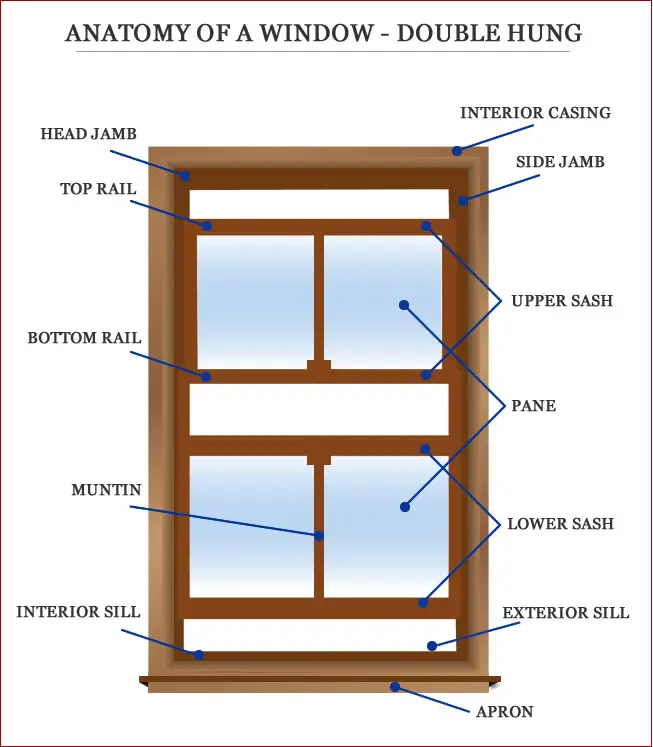Curious about the anatomy of a window? We have put together an illustration of a double-hung window along with the terms that describe the anatomy (parts) of a window. Of course, there are minor differences between replacement windows vs new construction windows. Additionally, we’ve included definitions of all applicable terms if you scroll down.
If you have any questions about your replacement windows project, send us an email and ask away!
Anatomy Of A Window: A to F
Apron
The apron is the horizontal piece/slat of trim beneath the window sill.
Argon Gas
A type of gas that is used to replace the air in double windows (krypton gas is typically used in triple pane windows). Essentially, argon gas increases the windows overall energy efficiency by decreasing the amount of heat loss.
Casing
A window casing is the trim around a window frame (inside or outside) that covers up the space between the end of the window and the wall. Casings are decorative in nature and hopefully add to the overall aesthetic of the home. Of course, if the casings don’t match the style and/or color of the walls, they can take away from the overall aesthetic. They are often made of wood for the interior and vinyl, aluminum, or fiberglass for the exterior.
Center Hung Sash
A sash that is hung or mounted on pivot pins in the center so the sash can be pivoted open in order for easy cleaning.
Frame
The outside part of a window (the perimeter) within which the sash and insulated glass unit are mounted.
Anatomy Of A Window: F to R
Head Or Header
The top of the window frame is called the head or the header.
IGU
This term stands for insulated glass unit. So, this is everything inside of the window frame – both panes of glass, the gas fills, and it’s own frame that keeps everything sealed up and tight.

Head Expander
U-shaped filler (usually made of vinyl) on the head.
Jamb
The window jamb is the side of the window frame – so both vertically and horizontally. The jamb provides structure and support for the window.
Main Frame
The main parts of a frame (the jambs (sides), head (top) and sill (bottom)). Basically, this is just another term for the frame.
Meeting Rail
Horizontal rails of two opposing sashes that meet when the unit is closed.
Mullion (or Muntin)
Separator (either vertical or horizontal) between two windows.
Pane
This refers to the window pane. Nearly all windows made today have double pane windows (some have triple pane). This means that each “pane” actually has two panes that are separated with a spacer system. The two panes adds lots of benefits, which include better soundproof windows, better energy efficiency, and long lasting window units.
Window Parts: R to Z
Rails
Window rails are horizontal structural components of the window’s sash. More specifically, they are horizontal pieces that help frame the glass panes that form the sash (in conjunction with vertical stiles).
Sash
The part of windows that contains the panes of glass. Specifically, sashes moves up or down to provide ventilation.
Sash Lock
A lock that works by having one portion of the lock on each of the meeting rails of windows (a cam lock on the lower sash and the matching receptacle on the upper sash).
Sill
The horizontal shelf that sits along the bottom interior of a frame. Additionally, most industry insiders prefer a sloped sill that sloughs off water without the water draining through the frame itself (like with weep holes).
Weep Holes
These are small holes in the exterior sill that allows any water to drain through the frame an out. Generally, weep holes are not a good design as they allow water to drain through the frame itself. Further, a sloped sill is the much desired construction technique.
Related Topics
Window Terminology
Components Terminology
Construction Terminology
Window Frame Terminology
Installation Terminology



